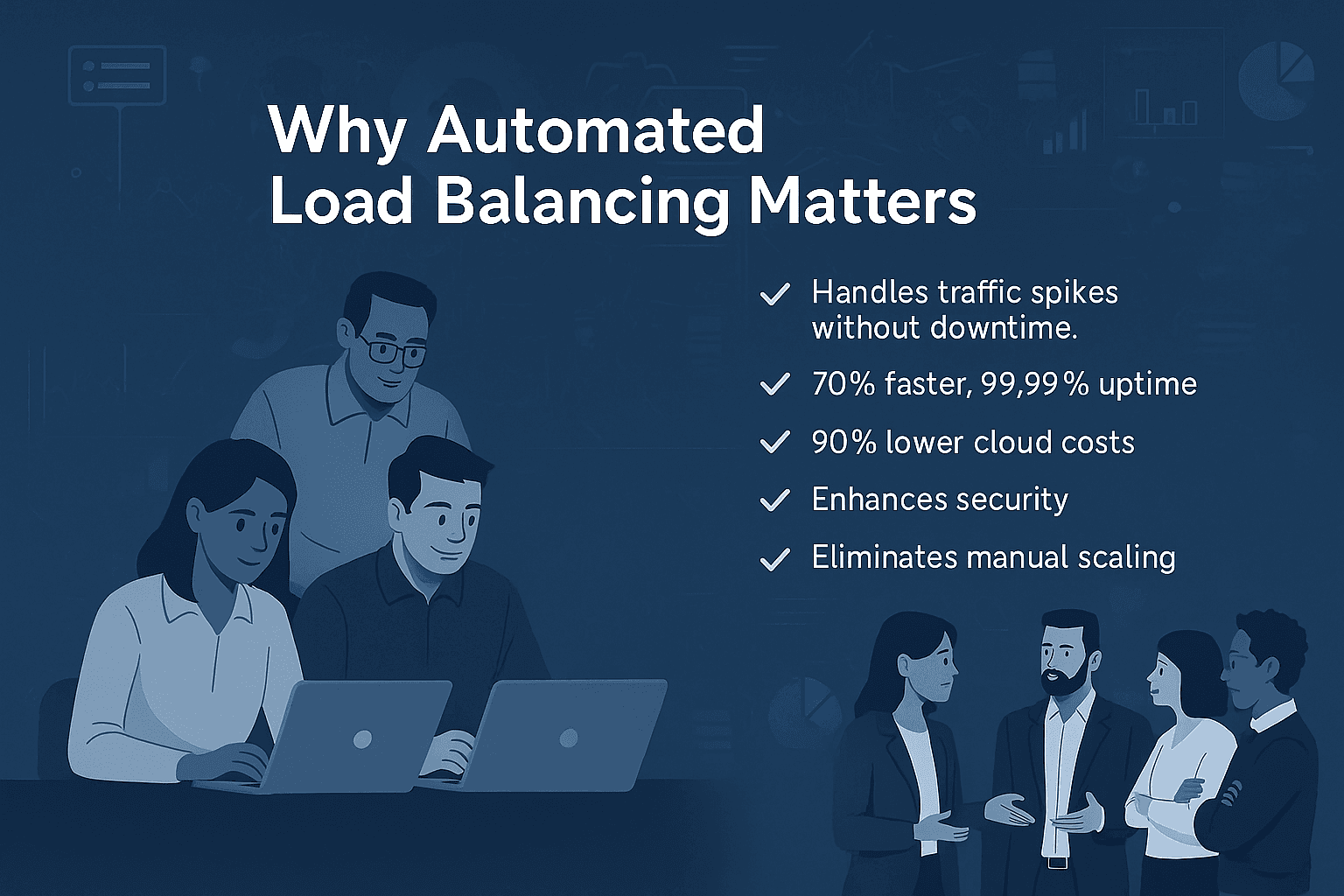
Tenant Data Isolation: Patterns and Anti-Patterns
Explore effective patterns and pitfalls of tenant data isolation in multi-tenant systems to enhance security and compliance.
Jul 30, 2025
Read More
Cloud apps need to handle traffic spikes without breaking. Automated load balancing makes this possible by distributing user requests across servers in real time, improving performance, reducing downtime, and cutting costs. Here’s why it matters and how it works:
Automated load balancing isn’t just about keeping apps running - it transforms how businesses manage traffic and expenses. Let’s dive into how it works and how to set it up.

Automated load balancing transforms how cloud applications manage traffic by distributing requests across servers automatically. It builds on the advantages of automation in scaling, fine-tuning how traffic is distributed to improve performance. Unlike older methods that rely on fixed configurations, automated systems keep an eye on conditions in real time and adjust traffic flow to ensure everything runs smoothly.
Think of load balancing as the traffic controller for your cloud application. It ensures no single server gets overloaded while others sit idle. It addresses key challenges like single points of failure and uneven server usage by spreading incoming requests evenly across the infrastructure.
"Load balancing is the process of distributing network traffic efficiently among multiple servers to optimize application availability and ensure a positive end-user experience." - IBM
A load balancer acts as a middleman between users and servers. It evaluates incoming requests based on factors like server workload, health, and response times. This setup prevents any one server from becoming a bottleneck. Through constant health checks, it can also redirect traffic away from servers that are struggling or down. This dynamic traffic management lays the groundwork for even more automation in load balancing.
Traditional load balancers operate with fixed rules, but automation takes things further by making immediate adjustments when traffic patterns change. This shift aligns perfectly with the seamless scaling strategies discussed earlier. Modern automated load balancers rely on algorithms like Round Robin, Least Connections, and IP Hash, paired with ongoing health checks, to optimize how traffic is routed.
Automation doesn’t stop at basic traffic distribution. It extends to seamless autoscaling and works across multiple layers, including network, application, and database levels. With internet traffic doubling annually, automation has become critical for handling the growing demand. For instance, in March 2023, Code.org used an Application Load Balancer to handle a 400% surge in traffic during online coding events without a hitch.
As part of a robust scaling strategy, automated load balancing not only boosts performance but also cuts down on operational workload. It can reduce server response times by up to 70%, significantly improving the user experience. A 2021 study of high-traffic websites found that effective load balancing increased average uptime from 99.74% to 99.99%, reducing service interruptions.
This technology also enhances security by distributing traffic across multiple servers, making it harder for denial-of-service attacks to overwhelm any single server. On top of that, automated systems improve resource management by scaling server capacity according to actual demand, reducing the risks of overprovisioning or underprovisioning.
The numbers speak for themselves. A survey by F5 Networks found that 67% of IT professionals incorporate load balancing into their infrastructure. Additionally, the Automated Load Balancer Market is expected to grow from $1.2 billion in 2024 to $3.5 billion by 2033, with an annual growth rate of 12.5%.
Looking ahead, organizations are increasingly integrating AI and machine learning into their load balancing systems. These advancements enable predictive traffic distribution and optimization based on patterns and system health. This marks a shift from reactive systems to ones that anticipate future needs, pushing the boundaries of what automated load balancing can achieve.
When it comes to automated load balancing, picking the right algorithm can make a big difference in how well your cloud application performs. Each algorithm has its own way of distributing traffic, and knowing their strengths and trade-offs helps you choose the one that fits your needs. Let’s break down the most popular options and how they work.
Load balancing algorithms vary in how they allocate traffic across servers. Some are straightforward, while others factor in server capacity or real-time metrics. Here’s a closer look at the most commonly used algorithms:
| Algorithm | How It Works | Strengths | Limitations |
|---|---|---|---|
| Round Robin | Routes requests one by one to each server in sequence | Easy to implement, works well if servers have equal capacity | Ignores server load and capacity differences |
| Weighted Round Robin | Assigns requests based on server-specific weights | Adjusts for different server capacities, more flexible than basic Round Robin | Requires manual configuration of weights, more setup effort |
| Least Connections | Sends traffic to the server with the fewest active connections | Handles unpredictable traffic well, assumes fewer connections mean a less busy server | Doesn’t account for differences in server processing power |
| Weighted Least Connections | Balances traffic by combining connection counts with server capacity weights | Considers both server load and capacity | – |
| Least Response Time | Directs traffic to the server with the fastest response time | Reduces latency, ideal for performance-critical apps | Requires precise response time tracking systems |
| IP Hash | Maps traffic based on client and server IP addresses | Ensures consistent user-to-server assignment, good for session persistence | Can cause imbalances if many requests come from a small number of IPs |
Static algorithms are best for predictable traffic, while dynamic algorithms adapt to real-time conditions but need more processing power. Choosing the right one depends on your app's specific requirements.
The best algorithm for your application depends on factors like server consistency, traffic patterns, and whether sessions need to stay tied to specific servers. Here’s a breakdown of when each algorithm shines:
To get the most out of your load balancing strategy, regular monitoring and optimization are essential. Even the most carefully chosen algorithm needs fine-tuning to avoid bottlenecks. Features like auto-scaling can help manage sudden traffic spikes, while redundancy planning ensures your load balancers don’t become single points of failure.
Keep in mind that more advanced algorithms, such as Least Response Time, require greater computational resources, which can increase complexity and costs. On the other hand, simpler options like Round Robin are easier to implement but might not handle more demanding scenarios as effectively. Striking the right balance between performance and operational overhead is key to long-term success. Regular performance reviews will help you adapt as your needs evolve.
Managing traffic spikes in cloud applications requires careful planning, and setting up automated load balancing is a key part of ensuring smooth performance. This process revolves around three main steps: configuring health checks, defining dynamic scaling rules, and implementing continuous monitoring with performance adjustments. Let's dive into each of these.
Health checks are the backbone of any effective load balancing system. They ensure that only healthy server instances handle traffic, preventing requests from being directed to servers that are down or underperforming - a scenario that could harm the user experience.
To make health checks effective, automate them for constant monitoring. Most cloud platforms let you schedule these checks to run at short intervals, such as every few seconds or minutes. Keep these checks lightweight by using simple GET requests on dedicated endpoints. At the same time, secure these endpoints by adding authentication or restricting access to specific IP addresses. It's also a good idea to test both internal and external dependencies to catch potential bottlenecks before they impact users.
For even greater reliability, integrate automated health checks into your CI/CD pipelines. This ensures that your system remains robust during deployments. Additionally, distinguish between critical and non-critical dependencies, so minor issues don’t unnecessarily trigger downtime or scaling events.
Dynamic scaling rules are essential for balancing performance and cost. Instead of relying on a single metric, use multiple metrics like CPU usage, memory consumption, and network activity to guide scaling decisions. Research indicates that multi-metric scaling policies can reduce false positive scaling events by 56%, making them far more efficient than single-metric approaches.
To avoid resource instability, set clear margins between scale-out and scale-in thresholds. For instance, consider scaling out when CPU usage exceeds 70% and scaling in only when it drops below 40%. This buffer prevents rapid fluctuations and keeps the system stable.
Combining scheduled scaling for predictable traffic patterns with reactive scaling for sudden surges can further enhance performance. Advanced autoscaling solutions have shown to significantly improve handling of unexpected demand spikes. Regularly revisiting and refining these rules as your application evolves is also crucial. When done right, autoscaling can cut operational costs by up to 47% and boost request-handling capacity by as much as 67% compared to static provisioning.
Continuous monitoring is the glue that holds an automated load balancing system together. Use comprehensive dashboards to track key metrics like response times, error rates, throughput, and resource usage. Setting up alerts for unusual activity allows you to address problems before they escalate.
Fine-tuning your scaling policies is an ongoing task. Regularly review your configurations and test thresholds to ensure they align with your application’s needs. Machine learning models can also play a role here, predicting resource demands up to 30 minutes in advance with 85% accuracy. This enables more proactive scaling decisions.
Finally, document your configurations and scaling strategies. This not only simplifies troubleshooting but also fosters better collaboration across your team.
After setting up automated load balancing, the benefits quickly become clear. This technology doesn’t just help handle traffic spikes - it reshapes how applications perform, how teams operate, and how businesses manage their cloud expenses. The improvements are measurable and impactful across multiple areas.
Automated load balancing significantly boosts application performance, with some organizations reporting up to a 70% improvement in performance and a 50% reduction in downtime. Average uptime jumps from 99.74% to 99.99%, which directly enhances user experience and protects revenue streams. Considering that just one hour of downtime can cost a business over $300,000, these improvements are financially vital.
Response times also see major gains, with organizations experiencing up to a 50% faster response time for their applications. This is crucial because over half of consumers abandon online purchases due to slow webpages, and nearly half won’t return after a poor experience. The stakes are high - slow-loading websites cost online retailers more than $77 billion annually in lost sales.
Real-world examples underline these benefits. For instance, Terminix uses Gateway Load Balancer to handle 300% more throughput, ensuring smooth operations even during peak demand.
By automating load balancing, businesses can eliminate much of the manual work involved in monitoring and scaling, freeing up teams to focus on more strategic tasks. This shift not only improves efficiency but also cuts costs.
Savings come from smarter resource allocation. Automated load balancing prevents over-provisioning and reduces power consumption by optimizing resource use. With auto-scaling, companies pay only for the resources they actually need, balancing performance with cost-effectiveness.
The financial impact can be transformative. Second Spectrum, a provider of AI-driven sports tracking technology, reduced its hosting costs by 90% using AWS Load Balancer Controller. Additionally, shifting IT infrastructure costs from capital expenditure (CapEx) to operational expenditure (OpEx) minimizes upfront investment. Businesses can scale up during busy periods and scale down during quieter times, avoiding unnecessary expenses.

At Propelius Technologies, we’ve built our cloud scaling solutions around these operational and financial benefits. From the start, we integrate automated load balancing into every scalable cloud application we develop. Whether through our Turnkey Delivery or Developer-for-Hire models, we ensure robust performance with continuous monitoring, redundancy, and proactive adjustments - especially during our 90-day MVP sprint engagements.
Our approach is practical and results-driven. When working with clients, we design load balancing architectures with redundancy to avoid single points of failure. This ensures applications are ready to scale from the ground up rather than requiring retrofitted solutions later.
For clients needing direct expertise, our Developer-for-Hire model embeds senior engineers within their teams. These experts bring deep knowledge of cloud scaling and automated load balancing, working alongside client teams to implement and fine-tune strategies. The knowledge shared during these engagements leaves a lasting impact, equipping organizations to maintain and optimize their systems long after our involvement ends.
With our Turnkey Delivery model, we handle every step of the process - from architecture design to deployment and ongoing optimization. Our years of experience solving real-world scaling challenges allow us to deliver reliable, high-performing cloud applications tailored to meet each client’s needs.
Automated load balancing has become a game-changer for cloud applications, streamlining traffic management, reducing costs, and ensuring reliable performance. With 94% of all workloads projected to run through cloud data centers and half of enterprises already spending over $1.2 million annually on cloud services, the need for smarter scaling solutions is only growing.
The benefits are undeniable. Automated load balancing ensures traffic is distributed evenly across servers, preventing both overloads and wasted resources. It also enhances application performance by managing sudden traffic surges. Reliability improves through features like traffic rerouting during outages, and costs are reduced by eliminating the need for on-premises appliances. These advantages extend to better security measures and stronger operational resilience.
"Effective load balancing allows organizations to meet the demands of cloud-based workloads while improving performance, enhancing reliability, minimizing downtime, and reducing latency." - Akamai
Security gets a boost as well, with automated load balancing offering protection against DDoS attacks by spreading traffic and enabling quicker recovery during network disruptions. These capabilities create a solid framework for scaling cloud applications to meet dynamic, real-world needs.
To make the most of these tools, it’s critical to implement autoscaling policies, conduct regular health checks, and choose the right load balancing algorithms from the outset. Regular performance testing and the use of predictive analytics to anticipate demand can further optimize resource allocation and scalability.
"Cloud scalability helps organizations save significantly on infrastructure costs by optimizing resource usage...ensuring that financial resources are not wasted on idle capacity." - OpenObserve.ai
Automated load balancing plays a key role in boosting cloud application security. By evenly distributing incoming traffic across multiple servers, it minimizes the risk of server overloads - an issue attackers often exploit during Distributed Denial of Service (DDoS) attacks. Spreading out malicious traffic makes it much harder for attackers to overwhelm any single part of the system.
Beyond just distributing traffic, load balancers actively monitor patterns for unusual activity. When suspicious behavior is detected, they can isolate it, reducing potential threats. This proactive layer of defense not only limits vulnerabilities but also helps keep your cloud applications stable and dependable, even during high-stress situations.
Static load balancing relies on predefined rules - like round-robin or weighted distribution - to assign tasks across servers. It’s simple and works best for applications with steady, predictable traffic patterns. However, it doesn’t account for real-time server performance, which can limit its effectiveness in more dynamic environments.
Dynamic load balancing takes a more adaptive approach. It distributes tasks based on real-time server load and performance metrics, making it a better fit for applications with fluctuating or unpredictable traffic. That said, it does require more sophisticated monitoring and decision-making processes.
When deciding between the two, think about your app’s traffic behavior. If your traffic is consistent, static algorithms are a reliable choice. For apps that experience sudden traffic spikes or irregular patterns, dynamic algorithms can handle the load more efficiently.
To set up automated load balancing for your cloud application, here’s what you need to do:
Automating this process helps keep your application responsive and dependable, even when traffic spikes.
Need an expert team to provide digital solutions for your business?
Book A Free CallDive into a wealth of knowledge with our unique articles and resources. Stay informed about the latest trends and best practices in the tech industry.
View All articlesGet in Touch
Let's Make It Happen
Get Your Free Quote Today!

Get in Touch
Let's Make It Happen
Get Your Free Quote Today!

